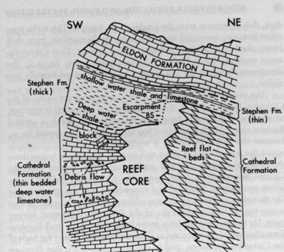Formation of the Burgess Shale
The Burgess Shale was formed about 530 million years ago during the Cambrian period. The Burgess Shale preserves the fossilized remains of a community of marine organisms that lived on mud banks built up against the outside of an algal reef. This algal reef had originally formed as vertical escarpment that eventually reached hundreds of meters in height.

Three formations comprise Mount Field, where the Burgess Shale is found. These are the Cathedral, Stephen, and the Eldon formations.
As illustrated on the diagram to right the Burgess Shale (BS) is found within the Stephen Formation.
Examination of the reef escarpment reveals much
about how the organisms inhabiting this area became so well preserved.
Many of the fossilized organisms were living close to the reef and reef escarpement. The muds in this area were unstable and frequent turbidity currents carried the sediments downslope into deeper waters. Many of the associated fauna were caught up in these slumps and were transported with the mud to become redeposited as graded units. Through geologic time, mountain building processes along with erosion have resulted the shale that we see today in Yoho National Park.
Overview on how the Burgess Shale was discovered
Return to table of contents
